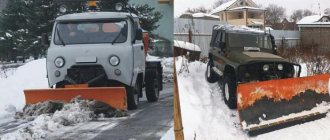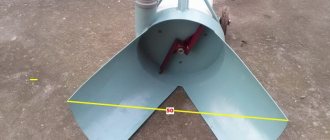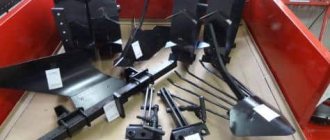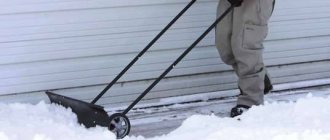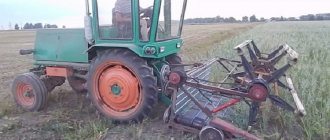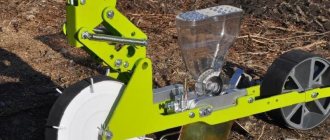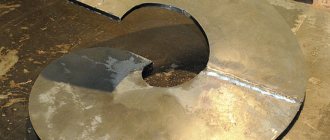Snow shovels
Before you go to the store to buy a suitable tool, you should find out which manufacturers produce the highest quality and most reliable snow removal equipment. But to ensure that your snow shovel doesn’t disappoint, you need to look beyond the manufacturer. The ease of use of the purchased device largely depends on the size and material. If you wish, you can consider the option of making a snow shovel with your own hands, but in this case, you will first have to find out all the nuances regarding such devices.
In the design of a snow shovel, two main elements can be distinguished - a bucket for collecting snow and a handle. Sometimes in stores you can find models that are made using a larger number of parts. But even with such differences, similar instances are intended to perform the same function.
Traditionally, wood, plastic and metal are used to make snow shovels.
Made of plastic
The plastic used by manufacturers must be frost-resistant.
For some models, it is complemented by a metal edging on the bucket, which allows the product to more easily withstand mechanical loads and increases its service life. Plastic shovels are more convenient to use due to their light weight. This is an ideal solution for women and teenagers. At the production stage, the material is treated with chemical compounds, and the area near the handle with the bucket is protected with a special edging, which makes the product more wear-resistant.
Made of wood
They are most often chosen by those owners who want to save money. The main disadvantage of such devices is the fragility of the material. In addition, wood tolerates moisture much worse than plastic, which very quickly causes cracks to appear on the surface. Wooden snow shovels are best used for removing recently fallen snow. In order to easily cope with ice and wet precipitation, you will need to additionally equip the bucket with a metal edging, which will increase the service life of the tool.
Made of metal
These shovels are the most durable and therefore last longer than other snow removal tools. But they are also more expensive than other types, although this is not surprising, given their high level of performance. Metal shovels can easily handle not only snow, but also ice.
To reduce fatigue, you can purchase a tool made of aluminum or duralumin, which weighs less than steel products. Aluminum is lighter than wood, but still does not have the same amazing strength as metal shovels. In comparison, duralumin looks preferable, because this material is much stronger, although much heavier than ordinary aluminum. Steel shovels require considerable physical effort, so, as a rule, only men work with them.
When evaluating shovels by weight, you also need to pay attention to the handle. For more convenient work, the handle must correspond to the height of the owner. Cleaning the area with a short-handled shovel will be very tedious.
It is equally important that the bucket has the appropriate width. The wider it is, the more snow you can collect in it. But to remove wet sediment, it is best to purchase a small shovel.
It is most convenient to clear the courtyard area of snow using a three-sided model, since it allows you to retain all the collected light and loose snow. Its bucket has longitudinal ribs that increase the degree of its sliding over the surface.
When choosing a snow removal tool, you need to pay attention to the nature of the work and the individual load.
To ensure that snow clearing equipment can be transported in a car and conveniently stored, manufacturers produce special folding and collapsible models. There are solutions for children too - small shovels that will allow even little helpers to take part in joint cleaning.
Achievements of progress - to the masses
A few decades ago, a shovel with a motor was found only in jokes. But today the most amazing and strange things have firmly entered our lives. Therefore, every person should know about such a cunning tool as an electric shovel.
Of course, this device doesn’t look too much like a shovel. Rather, it has something in common with a regular lawn mower. You need to hold the shovel by the handle, pressing lightly from above, so that the screw rake in as much snow as possible. The captured snow is thrown far to the side, where it will not cause unnecessary trouble.
Before purchasing, you should seriously consider whether you really need this tool. After all, its cost usually starts from 5 thousand rubles and can be much higher, depending on the manufacturer and power. Therefore, it is worth making such a purchase in cases where it is necessary to regularly clear snow from an area of tens of square meters. Then an electric shovel will help you save a lot of time and effort. A serious advantage is the minimal energy consumption: you just walk around the area, lightly pressing on the shovel, and it does all the work for you.
Light weight - from 6 kilograms - makes it easy to work with an electric shovel for both men and women, adults and teenagers
Of course, when working, you should exercise some caution so as not to get injured by the powerful screw of the device.
Making a shovel with your own hands
You don't have to spend money on buying a snow shovel.
If desired, each owner can make it himself, thereby saving not only money, but also time searching for a suitable model.
There are no particular difficulties in making a shovel for removing snow. Many owners of private territories have long been engaged in making wooden products with their own hands. But for those who are going to make a wooden snow shovel on their own for the first time, it wouldn’t hurt to first find out what materials will be needed for this work:
- nails and screws;
- wooden slats;
- strip of galvanized steel;
- plywood sheets 5 cm thick.
After preparing everything you need, you can proceed directly to assembling the tool:
- First you need to make a back wall, for which you will need a piece of plywood 4-5 cm wide. This part should be in the form of an arc and have a height in the center of no more than 8 cm, and in the area of the sidewalls it should narrow to 5 cm. For further fastening of the handle it is necessary to Make a cut in the middle with a bevel of about 1 cm.
- Now you need to attach the rail to the profile of the back wall and mark the place for cutting off the excess. In this case, the cutting will fit tightly into the cut.
- After the scoop is ready, it needs to be attached to the arc wall and secured with nails. Usually three nails are enough - one is driven exactly in the middle to the back wall, and the other two - on the sides. Be sure to inspect the bucket and make sure there are no gaps. Otherwise, during cleaning, stuck pieces of snow will be absorbed into the material, which as a result will very quickly deform.
- After making sure that the edge of the handle is closely adjacent to the plywood sheet, it must be secured with self-tapping screws.
- For the lower edge of the scoop, in order to strengthen the fixation at the junction of the handle with the back wall, you need to prepare steel strips of the required length. The finished strips are attached to the wood with self-tapping screws.
In order for the snow clearing tool to last a long time, it is advisable to make a bucket for it from stainless steel or galvanized metal.
Plastic tool
The easiest way is to buy a ready-made canvas and attach it to the cutting. Compared to a wooden tray, its plastic counterpart has the following advantages:
- The weight of a plastic scoop is about half that of wood fiber and oriented strand products. Snow does not spoil the plastic, so the shovel lasts longer; it does not even have to be stored indoors.
- Low price and availability. A plastic scoop is cheaper than an aluminum one and is sold in almost any hypermarket.
- The plastic must be hard and flexible. If the material remains intact after applying sufficient breaking force, it is suitable for making a scoop. Plastic barrels and similar used items are quite suitable for our purpose.
- We cut out the tray with an electric jigsaw or a fine-toothed hacksaw. The edges will turn out rough and uneven, but you should not process them, as they will be sanded down during the snow removal process.
- We attach the handle to the center of the scoop. Metal strips are applied at the joints. The fastening elements here are screws for plastic with a countersunk or semicircular head (provided the material is sufficiently thick). Nails and wire are also used for fastening, but in this case it will not be possible to remove large volumes of snow.
Read also: MTZ mini tractor: reviews
Scrapers for the garden
There are periods when there is more snow than usual, and you have to devote a lot of time to cleaning the area. It is not always possible to quickly cope with this task even with the help of a wide shovel. For such a case, it would not hurt the owners of private territories to have a scraper in their arsenal - a scraper for removing snow. In appearance, such a tool resembles a regular snow shovel, only with a wide bucket. With the help of this device, you can, without much effort, clear areas near your house and paths from snow masses.
Structurally, the scraper looks like a wide bucket for clearing snow with a large arched handle attached to it. Depending on the size, you can use this tool with two or four hands. Working together with a drag scraper allows you to clear an area of snow by moving large layers of snow.
But such devices can only be used for removing light snowfall. To remove compacted snow masses and areas of ice, you will have to use a shovel. Although for this case there is a good solution - a scraper on two or four wheels. With the help of such a shovel, you can clear the area of wet deposits without much effort.
Scrapers are similar to snow shovels in many respects. In particular, manufacturers use the same materials to make them.
Snow bag on the roof. How to avoid problems. Correct arrangement of the valley.
Snow bagging is a common problem on complex roofs. Forms at the junctions of different roof planes. Simply put, in the inner corners of the roof. Especially on the north side. This place on the roof is called the valley.
Snow and ice accumulate in these places. Moreover, it can reach substantial thickness. And if on the southern side the snow bags melt under the sun, then on the northern side they lie and accumulate all winter until April.
And the problem is precisely that due to spring melting, if the roofing is not done correctly, water can easily seep into the house and ruin your interior.
Why is this happening?
This happens because during the day the snow on the roof begins to melt. Even in winter. The snow bag only grows and gradually becomes saturated with water. At night the water freezes. The snow bag turns into an ice plug and interferes with the free flow of water. Water accumulates and begins to leak under the outer valley strip. As a result of this temperature leapfrog, more and more water freezes between the outer and inner valleys. And if the internal valley is not done correctly, then water leaks into the house.
How to avoid this?
Make the correct design of the valley.
The valley structure consists of three elements: continuous sheathing, lower and upper strips
Important point! The blue arrows show how the air should move. The roof must breathe!
Continuous sheathing is done due to the large snow load in these areas of the roof.
The top bar has a decorative function.
The bottom bar does all the work of collecting and draining water.
Upper strips are usually ordered along with the roofing.
The lower strips are factory-made, especially in roofs with a polymer coating such as ondulin.
Factory valley.
You can also order them from the company where you buy the roof. You draw the configuration, they will bend and cut everything for you. All that remains is to attach it in place.
But usually the bottom strip is made by the roofers themselves.
The bottom strip performs the most important part of the work of draining water, so we will consider the most common mistakes that are made when installing a valley.
Firstly. The bar is too narrow. The narrower the bar, the more likely it is that it will not hold water.
If this width will work for the southern side, then it is not enough for the northern side.
Sometimes, in order to save money, roofers or homeowners install a valley that is too narrow, and as a result, water gets inside the house. It is very difficult to fix this unit; you will need to remove all the roofing sheets lying on top.
It’s better to play it safe right away, in this case it’s completely justified.
And the size is good and the edges are curved.
Lay a wide valley with a side width of 50 cm and an overlap of at least 15 cm and the problem of leaks will never arise.
This is the right size! But for some reason the edges of the valley are not bent.
Secondly, this is the design of the unit itself. It's quite complicated.
It is important to remember that the roof must be ventilated.
The top figure shows two examples of laying an internal valley. The upper one is more reliable, the lower node can be freely used on the southern sides, for the northern side it is better to take the design of the upper node.
On seam roofs, a simple valley design is used.
Unlike other roofs, it is one and immediately has a decorative function.
On slate roofing, only one valley is also often used.
The method of fixing the valley depends on the type of coating.
In a seam roof, clamps are used; in others, as a rule, the valley is attached to a roofing screw.
A very important point. The edges of the inner valley should be curved inward. This side protects against water leakage into the roof space.
Remember one thing, it is better to assemble it once as it should be than to correct the jambs.
A properly assembled roof does not require any attention from the owners and serves well for many years.
Source
DIY making
To make your own snow scraper, you do not need to have any special knowledge. This tool differs from a regular shovel in that it requires more material. But even in this case, it will still be economical.
To make a simple wooden scraper yourself, you will need a wooden board and a couple of bars. One side needs to be covered with a metal strip to improve the sliding of the device. The bars will be needed to make a square frame, which is subsequently attached on one side to the board using self-tapping screws.
But we can offer another option for manufacturing a scraper, which involves adding wheels to the design. For such a snow removal tool, you need to prepare the following:
- Metal sheet;
- a handle in the shape of an arc (for example, from an old stroller);
- self-tapping screws;
- two small wheels;
- narrow steel pipes;
- conveyer belt;
- welding machine.
The process of making a snow scraper on wheels will look like this:
- First you need to process the sheet of metal, giving it the shape of a semicircle.
- It is necessary to make supports from narrow pipes. Then one end is welded to the scoop, and holes are made in the second for the wheel axle.
- From metal corners you need to make fixing ears for the racks. They also need to be welded to the scraper blade in the future.
- In order to make the structure lighter for the racks, you need to take two additional pipes, make three holes in them and select the optimal height of the handle.
- At the attachment points, the remaining elements of the tool must be secured with screws or self-tapping screws.
- To avoid accidentally damaging the scraper during snow removal, it is recommended to additionally attach a conveyor belt to its lower part.
- Finally, the scraper must be coated with colored paint.
It is not always possible to find metal sheets on the farm. In this case, it can be replaced with any unowned pipe of large diameter. You need to cut it into two parts, and then take one and use it as a scoop.
Winter is a difficult time for owners of private territories . At this time of year they have to regularly clear the area of fallen snow. But it will be easier to do this job if they have a special tool. Most often, a snow shovel is used for this purpose. But for larger territories it is not always enough.
In such a case, it won’t hurt to purchase a snow scraper. Although this device for clearing snow from an area can be made with your own hands.
Due to the fact that the scraper has a simple design, it can be made from lumber available in every household and thereby save a considerable amount of money. But the main thing is that the snow scraper will ideally meet the owner’s requirements, which will make the work as convenient and efficient as possible.
Basic rules and manufacturing criteria
An important point that cannot be neglected when drawing up a homemade drawing is the ratio of the amount of work to the power of the unit. When overloaded, components and mechanisms will quickly wear out, which leads to breakdowns and inoperability of the machine.
The manufacture of a blade for a walk-behind tractor must meet certain conditions:
- Durable material. For normal service, at least for several years, the knife must have a strong base. Any part of the shovel must be made to withstand loads and strong impacts.
- Exposure of sizes. A homemade blade should not be very wide or high. The optimal width is considered to be from 80 to 130 cm, and the height from 30 to 50 cm.
- Lifting mechanism. When developing a drawing, a lifting device in the form of hydraulics or levers can be added to the design. This function will allow you to transport snow or use the unit as a loader.
- Swivel joint. Using such a device, you can change the angle and inclination of the shovel left and right, up and down. Thanks to this, snow or debris removal will be carried out better and taking into account human needs. To turn up and down, you can make a structure similar to a rotary plow.
- Rubber. It is imperative to install a shock-absorbing strip made of dense rubber on the lower part of the blade. In this case, the walk-behind tractor is less damaged from impacts, and the bucket is less damaged from deformation and failure. The road surface is also protected.
- Speed of installation and dismantling. Since the walk-behind tractor is a universal device, its equipment should be carried out as quickly as possible without the use of special tools.
The blade can be placed on the front bracket, under the chassis or behind the walk-behind tractor. For mounting in the rear, you can use the attachment of the plow to the walk-behind tractor, which will greatly facilitate and speed up the work, but placement in front of the unit is considered the most suitable. This installation ensures maximum cleaning quality.
Read also: The steamer in the iron does not work
The finished product can be created and oriented in a horizontal or vertical position. The vertical option is chosen when space is cramped.
Types of homemade snow scrapers
All scrapers have the same device. The equipment consists of a handle and a working blade, which is used to directly clean the snow. However, the shape and size of these elements can be different, depending on the purpose of the tool. For example, roof snow scrapers have a long handle. It can be solid or telescopic. The working blade is fixed perpendicular to the handle. The scraper is more like a rake.
To clear snow from paths and areas, scrapers are made wide. The simplest option is a rectangular sheet of tin or plywood with a handle. The stalk can be one or two, as well as straight or curved. A U-shaped handle is made on wide scrapers.
If we talk about assembling a scraper for snow removal with your own hands, then a scraper of this type sometimes has a working blade with side sides. The bucket allows you to capture a large volume of snow mass and transport it to a designated location.
There are many configurations of snow removal equipment. However, all homemade snow scrapers have a main difference in the material they are made of. They create a tool from metal, plastic and wood:
- Plastic equipment is most often purchased in stores. However, you can make such a scraper yourself from a used plastic barrel, tray or other household item. The plastic is lightweight and snow does not stick to it. Due to these advantages, the work with the scraper is simplified. The edge of the working blade is usually protected by a frame made of a metal strip, which protects the plastic from abrasion. Store-bought products have stiffening ribs. They give strength to the working surface. Plastic scrapers are lightweight, convenient, and do not stick to snow
- The most popular tool for DIY assembly is a shovel-scraper for snow removal, where the material used is plywood and a wooden handle. It is not difficult to find a blank for such a tool in almost every home. Wood is easy to process, but has one drawback. Plywood strongly absorbs moisture. Over time, it begins to delaminate. A tool swollen with water becomes heavy, and wet snow sticks to the working surface. Wooden equipment is usually made from plywood
- In terms of strength, metal scrapers come first. However, not all equipment is created equal. Metal is a flexible concept. If you use ordinary tin and a pipe for the handle, then such equipment will quickly rust. It's heavy. Snow is frozen to the working surface. Inventory made of galvanized sheet steel is considered optimal in terms of price and quality. The protective coating prevents the rapid development of corrosion. However, the scraper is still a bit heavy. Over time, the galvanized layer wears off and rusty spots appear. Aluminum scrapers are considered the best. The tool is lightweight, rarely freezes with snow, and does not rust. You can also consider stainless steel, but the metal is expensive. Metal scrapers are durable, resistant to moisture and mechanical stress
Snow shovel made from PVC pipe: master class
This product is light, durable, and snow does not stick to it. Thanks to the reliability of PVC, the tool will not wear out or bend under stress.
To create a useful device you need to prepare:
- a piece of PVC pipe with a diameter of 20 cm;
- handle made of wood or aluminum;
- short screws;
- rivets;
- rail 5x5 cm;
- board 10 cm wide or more.
Tool making process
The first step is to create a mold for a shovel from lath. It should take the form of a furniture board measuring 46x46 cm. To do this, the slats are glued or twisted together, and the nose is slightly sharpened.
Advice! If there is no special tool, during the gluing process they immediately cut the slats diagonally one at a time, and then trim the parts with a plane already on the board.
Wooden shield for making a shovel
A chamfer is removed from the ends of the mold, four longitudinal tenons are cut out on it - they will form the stiffening ribs of the future shovel. If such work seems labor-intensive, use 4 thin slats instead of spikes.
A round groove is made in the central part of the form into which the handle will fit. The easiest way to round it is to cut it with a chisel and then burn the wood with a heated steel blank. A board edging is nailed along the perimeter of the form.
PVC pipe 20 cm
Next, proceed to the main stage of work:
- A piece of 40 cm is cut from a sufficiently thick and high-quality pipe, and an incision is made along it with a grinder.
- Connect a hair dryer and warm the workpiece well from the inside (put on gloves in advance). In this case, you should not linger in any area to avoid overheating of the PVC.
- Straighten the pipe, give it a flat look, pressing it with boards, plywood, or any unnecessary part of old furniture.
- Self-tapping screws are used to attach the PVC to the edging of the mold at the front.
- The plastic blank is heated again. The soft areas are pressed onto the mold immediately before they cool down, and the edges are screwed to the edging.
Handle installation
- The stiffening ribs are pressed through, and a rounding is also made for the handle. To do this, run a hairdryer over the corresponding areas of the PVC once again and crimp them with a block.
- To strengthen the handle area, cut a small plate from a piece of pipe, heat it and bend it. Then they make holes around the perimeter of the entire workpiece and fix the plate with rivets.
- Take the workpiece out of the mold, cut off the excess PVC from the edges with a grinder.
The shovel is almost ready. All that remains is to install the handle and drill it through with a bolt. The tool will be so durable that it will even be suitable for scraping ice. It will not break or bend for several seasons, and the cost of its production will be minimal!
How to make a snow scraper with your own hands
Before you start making a scraper, you need to think about its configuration and size. See what material is available. First of all, the equipment should be convenient for work. The cutting is made according to the height of the person. If the working surface is wide, it is optimal to provide a U-shaped handle.
For a wide scraper, a double U-shaped handle is provided
It is optimal to choose metal from the materials for the working surface. However, such a tool can scratch paving slabs. If the yard has such a decorative covering, then it is better to choose plywood or OSB sheet. You can make an excellent plastic scraper for snow from a barrel with your own hands if you cut out a fragment of the side wall. It is important that the plastic is not fragile and at least 5 mm thick.
The material for the handle is a wooden handle or an aluminum tube. It is not advisable to use a regular steel pipe. Such a handle will be heavy, cold, and uncomfortable in the hands.
The tools you will need are a saw, a jigsaw, a grinder, a hammer, a screwdriver, and an electric drill. The exact list depends on what material will be used for the work.
Video of DIY snow scrapers:
Model selection
Manual wheeled bulldozers are produced by many manufacturers. The principle of constructing snow cleaning equipment is the same. Dimensions, design and some minor design nuances differ.
Snow shovel on wheels Elektromash
A popular domestic development is a manual two-wheeled bulldozer. Equipment allowing for cleaning work has the following characteristics:
- The blade is made of 2 mm steel. Working width 70 cm.
- Movement occurs due to 2 wheels. The rubber run does not damage the decorative surface of paving slabs.
- The blade is equipped with a mechanism that allows you to adjust the angle of rotation.
- The tool is easy to operate thanks to the adjustable handle. The length is set according to the height of the operator.
- A special stop prevents the lower edge of the knife from cutting into the ground during harvesting work.
The weight of the tool is about 11 kg. Light weight and high maneuverability allow an elderly person to operate the blade.
Wheeled snow shovel Bulldozer
The two-wheeled blade of the “Bulldozer” series is distinguished by increased bucket dimensions. In one pass, the working width of the strip is 80 cm. Plastic wheels do not damage paving slabs. The Bulldozer model has the following characteristics:
- The steel blade easily cuts off ice build-ups and compacted snow layers. Durable metal does not deform from impacts against hard objects during cleaning.
- The adjustment mechanism of the blade allows you to change its angle to move snow accumulations to the edge of the curb.
- The handle is equipped with two adjustment mechanisms. The operator is given the opportunity to change the angle of inclination and length.
Even an elderly person can clear snow drifts with a two-wheeled bulldozer, applying a minimum of physical activity.
Shustrik-3 device
The two-wheeled device “Shustrik-3” is characterized by increased maneuverability. The tool is easy to move over obstacles; you can simply carry it by hand or roll it on one wheel, lifting one side. Even a child can use the scraper. The handle is equipped with an adjustment mechanism that allows you to change its length. The blade is convenient to maneuver on narrow sidewalks, enter hard-to-reach areas, and go around obstacles when cleaning areas with flower beds, pillars, and sculptures.
The steel ladle is 60 cm wide and 20 cm high. The width of the adjustable handle is 41 cm. The tool is equipped with a rotating mechanism. When removing snow accumulations, the bucket is directed to the right or left. If you just need to push the snow out of place, the blade has a turn to the other side.
The video demonstrates the removal of snow mass by a nimble:
Shovel Snowball
The four-wheeled shovel “Snowball” will replace a full-fledged bulldozer and will help clear snow over a large area with minimal effort. The inventory is managed by one person. However, 4 wheels, a powerful frame, a wide bucket and a handle allow you to use the tool with greater productivity. If you put 2 people in control, you can use a shovel to move large accumulations of snow, knock down ice build-ups, and clean compacted wet layers.
The adjustment mechanism allows you to set the desired angle of rotation of the bucket. Rubber wheels do not damage the sidewalk surface and move the cart smoothly over uneven surfaces. Control occurs at full height or at an angle, which is chosen by the operator himself.
Video about using the four-wheeled snowball tool when clearing snow:
DIY snow scraper made of metal
If desired, you can make two versions of metal equipment: with and without sides on the working surface. The easiest option is the second one. For a working blade, a rectangular blank is cut out of sheet metal using a grinder. The height of the scraper is about 50 cm. The width depends on how many people the tool is designed for. If one operator will operate, the parameter is limited to 60-70 cm. For two people, the width of the working surface is increased to 1 m.
The handle is a wooden handle. It is installed alone on a narrow canvas. A wide scraper is equipped with two cuttings, and at the end they are connected by a jumper. The handle is shaped like the letter “P”.
The presence of sides allows you to capture more snow
Using the scraper principle, you can construct a homemade snow scraper with your own hands if you equip it with sides. Here too there are two options. In the first case, the rear and two side sides are bent from metal. If you make them high, the bucket will be convenient not only to scrape off, but also to remove snow from the site.
In the second option, the metal ones bend only the side sides. The back shelf is made from boards. It additionally serves as a solid basis for fixing the cutting.
General requirements for the product
A snow shovel is an indispensable assistant in winter. In order for it to serve for a long time, manufacturing must meet a number of conditions. Shovel requirements:
- The bucket must be strong to withstand the load.
- The desired shape of the bucket is ribbed. This will make it easier to glide through the snow.
- The end of the handle should have a rubberized grip. This will avoid slippage.
- The length of the cutting is 1.5−1.8 m. Depends on the height of the person.
When designing the structure, it is advisable not to provide a folding handle, as this reduces strength. The width of the bucket depends on physical capabilities: the more weight a person can lift, the wider the bucket can be made. A wide shovel can remove more snow at a time than a narrow shovel. But there is no point in this if you can’t lift that much weight. After drawing up the drawing, production can begin.
The simplest option for a DIY snow shovel would be a wooden product. Medium in complexity - plastic and metal. The most difficult things to make are rollbacks and auger cleaners.
How to make a snow scraper for skis with your own hands
The disadvantage of all inventory is the complexity of management. While pushing, the scraper collects snow well only on a flat surface, but no matter how smooth it is, the working surface still hits pieces of ice, ground and other obstacles. Each blow is reflected by the load on the back. A cleaning device installed on the skis helps solve the problem.
The working blade mounted on skis does not rest against the ground when raking snow.
To make your own snow scraper, use a grinder to cut off two corners, pipes or tires 1 m long. The ends are bent, otherwise the skids will hit the ground while moving. A U-shaped handle is bent from a tube with a diameter of 15 mm. It is welded to the runners at an angle. Bend towards yourself. The angle is determined individually so that it is convenient to control. A rectangular metal sheet is bolted to the posts of the U-shaped handle. The lower edge of the working blade should be on skis so that it does not rest on the ground.
How to make a snow scraper from plywood
For snow removal equipment you will need a plywood sheet 6 mm thick. The workpiece is sawed off to a length of 0.8-1 m and a width of 50 cm. The plywood is bolted to a U-shaped handle curved from a metal pipe or assembled from wooden cuttings. The scraper is almost ready, but it’s too early to clean the snow with it. In this form, the ends of the working cloth quickly wear out. The plywood begins to delaminate and break off in splinters.
It is optimal to frame the plywood with a steel strip
To improve the design, the lower end of the working blade is framed with a steel strip. It is fastened with rivets through through drilled holes.
Attaching the blade to the tractor
Most walk-behind tractors are equipped with a standard bracket for attaching attachments. It can be used to attach the front shovel of a tractor. If necessary, you can make an adapter to ensure that the blade turns to the left or to the right. When installing the bucket at the rear of the machine, skimmer mounting technology can be used.
Making the front bucket mount:
- Weld a profile pipe onto the back of the bucket. For reinforcement, it can be bolted after welding.
- Make a semicircle with a radius of 10 - 12 cm from a metal sheet 1 cm thick. The workpiece must be welded to the profile pipe. Holes are drilled in a circle to make it possible to set the angle of rotation of the blade.
- When making a shovel, the holder is also made. To do this, you need to make a “g”-shaped profile from a square pipe. The short side of the holder is attached to the rotary sector, and the other edge is rigidly fixed to the tractor bracket. The height will be adjusted using bolts screwed into the adapter.
There is a simpler method of fastening; for this, eyes and locks made of durable steel sheet are used.
Do-it-yourself scraper for removing snow from the roof
Snow covers not only paths, but also roofs. On the one hand, he doesn’t interfere there. However, it needs to be removed. Large accumulations of snow can cause the roof to collapse, and when an avalanche falls from the roof, there is a risk of injury to a person. A regular scraper won't do the job here. A long-handled device will be required. There are many options, but one of the simplest designs is considered to be a rake scraper.
They begin to assemble a homemade scraper with their own hands for removing snow from sawing off boards. The workpiece is taken up to 800 mm long and up to 200 mm wide. In any case, the board must cover the rake teeth, otherwise they will damage the roofing.
The board is fixed to the rake with a steel tire and self-tapping screws
The board is laid on the ground. A rake is placed perpendicularly on top. In this position, the teeth are parallel to the plane of the board. Now the elements need to be securely fastened. To do this, take a tire. Its length should exceed the width of the rake. Holes are drilled in the tire, placed on the teeth, and screwed to the board with self-tapping screws.
Snow is cleared from the roof by moving it towards you with a rake.
The only drawback of the design is the short handle of the rake. It is extended with an aluminum tube or a long wooden strip is used.
How to make a snow scraper from 0SB
When you urgently need to remove snow, and you only have a piece of OSB board at hand, you can make a scraper using simple manipulations with a jigsaw. To assemble a scraper with your own hands for clearing snow, you don’t need drawings, but you need to build a pattern.
On the OSB board, draw the shape of the future scraper with a pencil. Towards the bottom, the drag scraper is expanded to 1 m. The corners are slightly rounded. Toward the top, the plate is narrowed approximately 30 cm from each edge. Two oblong holes for handles are drawn on the pattern. Now all that remains is to cut off the excess parts of the OSB board using a jigsaw according to the markings. The area near the handles is carefully sanded with sandpaper. For convenience, they can be wrapped with electrical tape.
How to make your own snow removal device
How to make a snow scraper? It all depends on the type of construction and materials (metal, wood, very rarely plastic). Whatever the choice, the homemade product must meet three parameters:
- structural strength;
- a high-quality handle that will not slip in your hands;
- the tool should be light.
It is not difficult to comply with these parameters if you follow the instructions.
Wooden scrapers
The most affordable DIY scraper can be made from wood and plywood. For this you will need:
- plywood “4”, the size of the piece can be adjusted to suit you, but the optimal one is half a meter by half a meter;
- thin board for the end of the scraper;
- stainless metal strip for finishing the working edges of plywood;
- nails (or screws);
- a ready-made handle from a rake, shovel, etc. (the material can be any);
- hammer (or screwdriver), saw, grinder for cutting metal strips, sandpaper, pliers.
Sequencing:
- give the piece of plywood the required dimensions;
- we adjust the wooden board to the length of the back of the plywood, make a hole in the middle of the board for the handle;
- prepare three metal strips, each of which should match the length of the edges of the plywood;
- Before assembly, we sand the edges of plywood and metal elements;
- bend the metal strips with pliers along the edges of the plywood;
- nail the plywood to the board, insert a handle into the hole in the board (additionally, it can be attached to the plywood with metal strips).
The tool is ready! More meticulous craftsmen can make a version of the scraper with a slightly bent piece of plywood. The drawing is the same, but the board for the end part will need to be made not rectangular, but slightly rounded at the bottom. For larger products, it is worth taking “six” plywood so that it can withstand the load, and build two handles so that you can push with both hands.
It will be convenient to remove snow on the roof with a plywood shovel, since the design is lightweight and will not damage the slate.
Metal scrapers
Metal snow removal equipment comes in two forms.
Shovel scrapers are the simplest in design. You can make a metal product according to the same drawing as a plywood one, bending the sides on the non-working sides (usable sheet size is 30x50 cm):
- you will need a steel sheet, a metal tube;
- the metal tube must be given a U-shape so that the ends of the tube can be welded to the edges of the sheet (you can choose the size of the sheet to suit yourself, but not more than 50x50 cm);
- To strengthen the sheet, the three non-working sides from the inside can be “swept” with reinforcement or internal reinforcement can be made from cable.
The materials most often used for metal products are galvanization (about 1 mm thick), steel sheet or duralumin or aluminum. It is recommended to trim the bottom of the working edge with a conveyor belt: then the blade will not spoil the coating.
Buckets are, as a rule, intended for cleaning large areas, although you can make a small bucket even for a child:
- as a base you need a trapezoidal metal sheet and a metal tube;
- We form the sides of the sheet - we bend the back one (on the wider side of the sheet), the corners will have to be cut in order to bend the side boards;
- so that the structure does not deform, it must be trimmed with corners along the bends of the bucket;
- the handle of the product is made U-shaped and welded to the upper edges of the bucket.
You can go another way: first form a base from reinforcement and weld the sides and bottom of the bucket to it separately. The result of the work can be seen in the photo.
What are its advantages and what does it represent?
To call it a shovel, of course, would not be entirely correct; the name soil loosener is more appropriate for it. It is a bunch of one or two original villas, intelligently connected to each other with additional supports for the feet, for more convenient cultivation of the land, and a small handle. It is advisable to make (or buy) a handle in such a way that it is up to your shoulders, otherwise when working in your summer cottage it will be uncomfortable for you, or the meaning of such an invention will be lost.
Its purpose includes such things as:
It’s enough to just dig up various root crops. It’s easy and without any problems to get various kinds of weed (without destroying it into small parts, which is important) And also breaks down and loosens the soil
One of the disadvantages of the miracle shovel is its weight. But don’t worry about the fact that you will constantly drag it around your summer cottage; you will only have to get it onto the soil once and move it along the way with small pulls using the handle. If you compare it with the load that you apply when using a simple shovel, then you will spend 2 times less force on the same area. However, it is impossible to dig a hole with this shovel.
There is another type called “digger”
At first glance, you will immediately notice that you see very large forks with a large handle, to some extent this will be true. They are three times wider than ordinary forks; their powerful handle makes it easy to turn out the earth. The footrest of such a tool is very convenient, since you can stand on it with both feet, which makes it easier to drive it into the ground. If desired, such a digger can be quite easily made with your own hands. But if you decide to purchase a tool, one of the advantages is that the level of the handle can be adjusted according to human height. For this purpose there are special bolts installed on the iron “handle”.
Including there is another version of the miracle shovel called “Lightcopper”
It can be compared with the previous version, since they are almost identical, at first glance, it looks like a large fork, but only with a modified handle. It is made in the form of an arc and does not have the ability to change the height of the handle, which can be attributed to its negative features. Well, as you can see, from the name it is quite easy to use when working on the ground.
The principle of making a miracle shovel at home according to drawings or videos
If you decide to make a miracle shovel with your own hands, then the first thing you need to do is make a frame base. To do this, you need pipes with a diameter of approximately 30 mm and a wall thickness so that they are not less than 3 mm, otherwise the frame will not be rigid and will constantly sag or break. In addition, when making a miracle shovel, you will need hard corners with a thickness approximately the same as the pipes for structural strength.
All you have to do to the prepared frame is to weld the teeth with which you will plow your plot. Many self-taught people use ordinary pitchforks for this, which are first cut and then welded onto the finished structure. The main thing when choosing is to rely on the fact that the pins are quite strong and powerful, preferably with a diameter of at least 8–10 mm. There will not be much difference if the pins are round or in the form of another geometric shape. On average, you will need eight or ten pieces for them, depending on the width of the frame you make, rely on the fact that there should be an approximate distance of 65–75 millimeters between the pins.
First of all, when making a miracle shovel, rely on your capabilities and dimensions, adjust all sizes individually. Don’t forget that the miracle shovel for digging the earth with your own hands is designed to make it easier to spend time at your summer cottage; try to make it with your own hands as suitable as possible for your size.
If you are not a lazy person, then it will not be a particular problem for you to make it the most convenient for digging your garden plot.
Wheeled snow scraper
Among the “mechanical” snow removal equipment at home, you can make two types of construction: on skids or on wheels. The assembly principle is similar. To make a wheeled device, the basic materials you will need are:
- a metal pipe (up to 30 cm in diameter), which will serve as a dump;
- two-wheeled frame of an old wheelbarrow or stroller (“sliding” version can be placed on the frame of an old sleigh);
- metal pipe for the handle.
You can assemble the structure as follows:
- We cut off a part from the pipe, a little more than half the diameter - this will be the blade of the tool;
- We weld the frame axles to the blade;
- on the other side of the frame, a handle made of a metal tube is welded (to make the structure more reliable, it is better to make fasteners for the racks from metal corners).
Don't forget to attach a transport tape to the bottom of the working part. To prevent the metal scraper from being corroded, it is best to paint it.
Among the simple and common models of homemade scrapers, one of the popular options is a small brush scraper (you just need to attach a handle to a hard brush). This design is useful for clearing snow from a car. In addition to simple models pushed by hand force, you can make a wheeled model with an engine.
Homemade scraper for removing snow from plywood and boards
As they say: “if you love to ride, you also love to carry a sled,” and in winter, when a lot of snow falls, you have to constantly clean the local area and driveways. And to clear the snow debris, scrapers in the form of a large shovel (and, in fact, in the form of a bucket) are used.
And everything would be fine, but store-bought scrapers, made of thin plastic that sticks to the snot, are somehow already very expensive. Not everyone will want to overpay, especially since the service life of such a scraper is at best for one season.
And therefore, if you have free time, tools and material, you can make a snow scraper from plywood and boards. To make the bucket, the author uses a small piece of plywood 4 mm thick.
Main stages of work
Next, you will need to make the side walls of the scraper, which will be attached to the plywood. And for this, the master cuts two blanks from the board. If you have an edged board available, the work will not take much time.
At the next stage, you will need to screw the plywood to the side walls with self-tapping screws. For reliability, it is better to glue the boards and plywood together. PVA is not suitable for this purpose - it is afraid of moisture, but you can use polyurethane foam.
Then all that remains is to strengthen the lower part of the bucket with a galvanized strip and attach the handles, which the master made from wooden slats. To protect it from moisture, it is better to coat the scraper with a layer of varnish.
You can watch the detailed process of making a homemade snow scraper from plywood and boards in the video on our website.

